Whenever I hear someone refer to revolver and autoloader handgun grips as “handles” I want to beat them with the stick end of a broom. I am fairly convinced that the “handle” reference is the work of an arrogant little boy, who has intruded into a world he doesn’t understand, and is too lazy to learn the vernacular. On the hand, it is almost cute when spoken by a bubbly, vivacious, vacuous beauty in search of knowledge.

There are two firearms I am particularly fond of; the Ruger GP100 357 Magnum and the Marlin Model 1895 Guide Gun 45-70 Gov’t lever action rifle. That just means when I am not working on a scheduled project and I want to enjoy a little free time shooting and handloading, these two firearms are the points of focus. The only problem is that I do not like the factory grip on the Ruger, pictured above.
The factory grip is too thin, too… humped and too uncomfortable in the palm of the hand. The angle formed between bore centerline and the front line of the grip is too shallow, which puts the front sight high when I first aim, then I need to push my wrist downward into an uncomfortable position to gain proper sight alignment. Finally, with the web of my hand crowding the top of the grip, my top fingers do not tightly grasp the grip. OK, really finally, the finger grooves do not accommodate my fingers, as they enter the grooves at a downward angle, they do not wrap straight across.
The GP100 frame angle, grip peg relative to bore centerline, is 123.5º. The standard grip angle is 109º through its centerline. While Super Redhawk and GP100 grips are interchangeable, they are slightly different at 123º and 108º respectively.
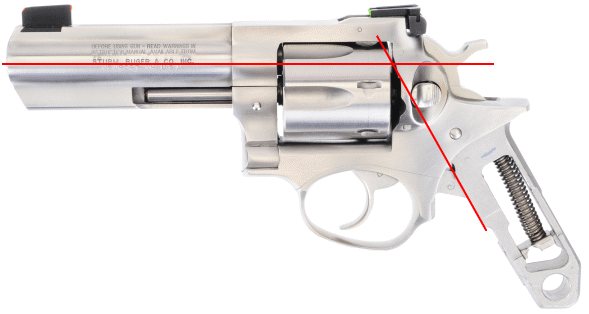
Measured to the same reference interior angle, a 1911 type bore centerline to grip angle is 106º, one of the best grips in handguns, which should place the GP100 in good grip company… but not so fast. The difference is that trigger finger tip contact on the GP100 is 1 3/4″ below the hand’s web contact high on the backstrap. This places the trigger finger on a steep angle and bunches the three remaining fingers under the trigger guard.
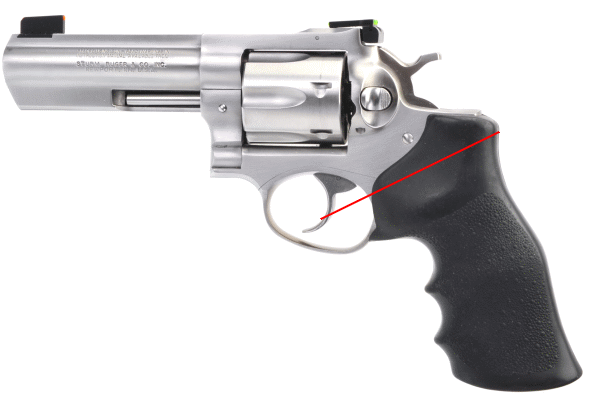
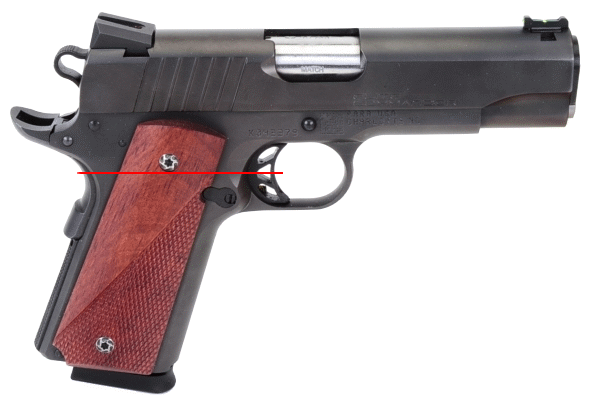
The 1911 positions the web of the hand and trigger finger in a straight line, parallel to bore centerline, which allows the three remaining fingers to grasp the front strap in a more comfortable fashion. The combination of grip angle and trigger finger angle can increase the force required to pull a trigger by placing the angle of effort out of alignment with the angle of mechanical resistance… really.
A reversible jacket and two pairs of pants…
A long time ago, a custom grip order form began with a tracing of the customer’s hand so that the custom grip maker could accommodate hand and finger size and customer preferences. The more developed the shooter, the more meaningful the result of a custom fit. Now that we are mostly a nation of posers, custom grips have come to mean, “Check the box next to the type of wood or other material you’d like and whether or not you’d like checkering or finger grooves”. There are a few real custom grip makers and their product lines are restrictive… and expensive.
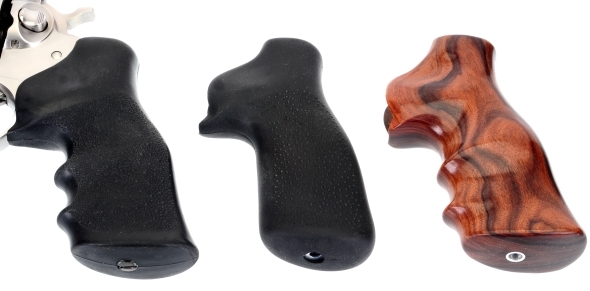
The thing is, every angle, bump, back rise, and side swell alters point of impact and when they don’t suit the shooter, the hand, wrist and arm must move out of a natural shooting position to compensate. Far left, the Ruger branded one piece Hogue Monogrip is constructed of rubber molded over a hard Nylon shell. For me, the grip places the front sight high, sets my wrist at an awkward angle to my forearm and tends to exaggerate muzzle jump. Most of the misfit with my hand is the hump back.
The middle grip, another Hogue Monogrip, sans finger grooves and formed to a different angle and with a significantly different rear profile. This grip tends to place sights in alignment with a natural point and with my wrist aligned to my forearm and in a comfortable position. I would attribute most of these good things simple, clean lines and no pronounced hump. This form is also the closest to the wood grips supplied with the Ruger Match Champion.
The far right grip is a Hogue Pau Ferro version with finger grooves. Pau Ferro is Portuguese for “It is illegal to sell real Rosewood anymore”. While the grip is formed in a relatively tight front angle, it is thicker than either of the other two. This tends to stretch out my trigger finger, it increases trigger pull effort and it tends to pull my shots left when first used as a result of over compensation for a stressed trigger finger. Below, a rough approximation of dimensional differences.
|
Grip |
Front Angle |
Back Angle |
Front Length |
Back Length |
Back Grip Rise |
Grip Width Trigger Finger |
Trigger Finger Reach |
| Hogue Monogrip – Grooves | 105º | 110º | 2.30″ | 4.20″ | 0.75″ | 1.06″ | 3.25″ |
| Hogue Monogrip – No Grooves | 95º | 105º | 2.40″ | 4.10″ | 0.60″ | 1.09″ | 3.25″ |
| Hogue Wood – Grooves | 100º | 105º | 2.30″ | 4.20″ | 0.80″ | 1.16″ | 3.50″ |
Front Angle = Interior angle formed by bore centerline and forward grip surface.
Back Angle = Interior angle formed by bore centerline and Rear grip surface.
Front Length = Measurement from the grip curve aft of the trigger guard to end of finger surface
Back Length = Measurement from the rear top of the grip to end of palm contact surface
Back Grip Rise = The height of the hump on the grip back relative to hand web contact surface
Grip Width Trigger Finger = The thickness of the grip where the trigger finger crosses
Trigger Finger Reach = The measurement from the center rear of the grip top to the trigger face.
A good tool for checking grip angles, as well as rifle stock drop is a Goniometer. At $8 on Amazon, it is an inexpensive tool to have around and if things get boring at the office, you can have a “Whose forehead slopes the most?” contest.
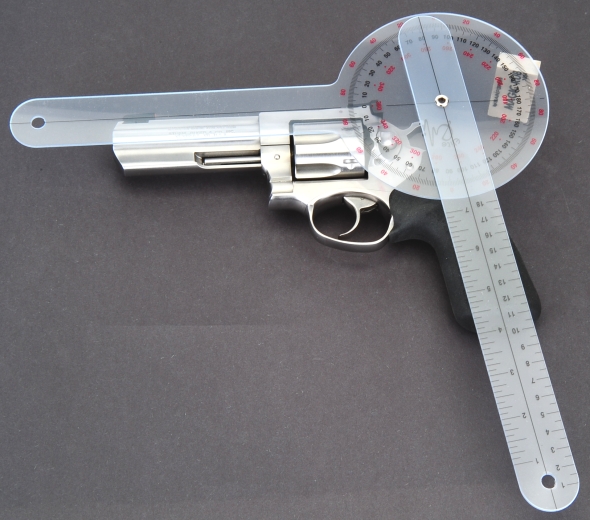
Don’t miss what’s fun about firearms….
I think it has become the norm to team think trends or follow the mass of concurrence. We stop looking at the firearms we shoot, we stop experimenting and we become content with not knowing much about the details of what we shoot. It is common place for people to think of handgun grips as something decorative, as though they don’t contribute to shooting precision and speed.
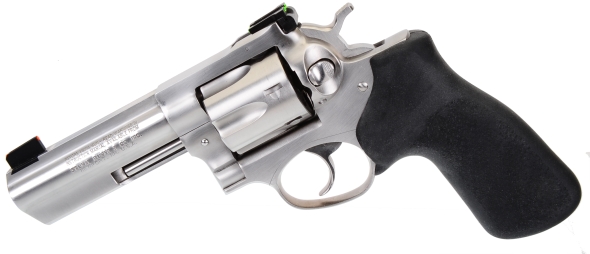
The next step will be to string wind the low points, shave off the high points and use double face tape until the offsets are just right. Then I’ll either shoot it that way and live with the less than aesthetic pleasantries, or put a file, filler and sand paper to the wood grip until it looks and feels like the interim Frankenstein. Grips are more then a decoration.

Email Notification